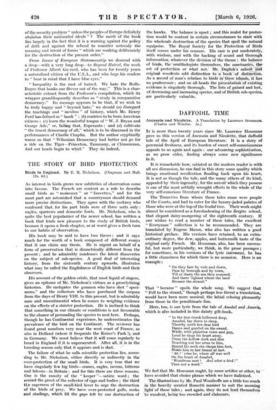THE STORY OF BIRD PROTECTION
As interest in birds grows new subtleties of observation come into' favour. The French are content as a rule to describe small birds as " moineaux " or " fauvettes," and for the most part are astonished that a countryman should demand more precise distinctions. They agree with the cockney who confessed that for his part birds were of three sorts only : eagles, sparrows and domestic fowls. Mr. Nicholson, who is quite the best popularizer of the newer school, has written a book that lends new pleasure to the study of British birds, because it opens a fresh chapter, or at worst gives a fresh turn to our habits of observation.
His book may be said to have two theses ; and it says much for the worth of a book composed of different essays that it can claim any thesis. He is urgent on behalf of a form of preservation that is diametrically different from the present ; and he admirably -condense; the latest discoveries on the subject of sub-species. A good deal of interesting history, from the sixteenth century upwards, illustrates what may be called the Englishness of English birds and their observers.
His account of the golden oriole, that most liquid of singers, gives an epitome of Mr. Nicholson's virtues as a ,proselytizing historian. He castigates the gunmen who have shot " speci- mens," and the collectors who have purchased the corpses from the days of Henry VIII. to this present, but is admirably sane and unsentimental when he comes to weighing evidence on the effects of a stricter protection. He is inclined to think that something in our climate or conditions is not favourable to the chance of persuading the species to nest here. Perhaps, though he has Continental experience, he underestimates the prevalence of the bird on the Continent. The reviewer has found great numbers very near the west coast of France, as also in Holland (where it frequents the Kaiser's Park !), and in Germany. We must believe that it will come regularly to breed in England if it is unperseeuted. After all, it is in the breeding season only. that it appears and is shot.
The failure of what he calls scientific protection lies, accor- ding to Mr. Nicholson, either directly or indirectly in the over-protection of the small birds. It is very true that we have singularly few big birds—cranes, eagles, ravens, bitterns and falcons—in Britain ; and for this -there are three reasons. One is the enmity of the " keeper "—satiric word ; the second the greed of the collector of eggs and bodies ; the third the eagerness of the small-bird lover to urge the destruction of the birds of prey. We have over-protected gulls, rooks and starlings, which fill the gaps left by our destruction of
the hawks. The balance is upset ; and this zealot for protec- tion would be content in certain circumstances to start with the wholesale destruction of the species that spoil the natural equipoise. The Royal Society for the Protection of Birds itself comes under his censure. His case is put moderately, with wisdom, and with the backing of sound and thorough information; whatever the division of the theme : the balance
of birds, the -ornithologists- themselves, the the art of protection or what not: Mr. Dogfish's salierntA011 original woodcuts add distinction to n book- of distinetiOn. As a record of man's relation to bird; id these islinds, it has no predecessor; and on all heads the Presentation-of existing evidence is singularly thorough. The lists of gained and lost, of decreasing and increasing species, and 'of British sub-species. are particularly valuable.






































































 Previous page
Previous page